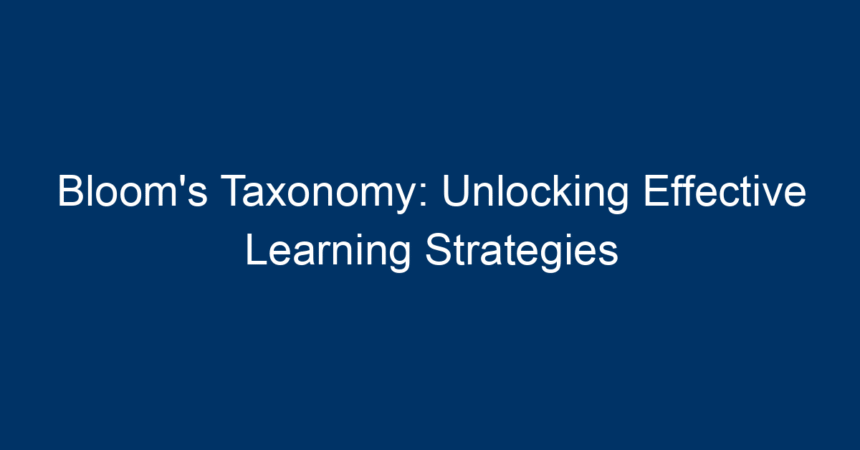Introduction
In today’s fast-paced educational landscape, understanding how we learn is paramount to developing effective teaching and learning strategies. One powerful framework that has stood the test of time is Bloom’s Taxonomy. Created in 1956 by Benjamin Bloom and his collaborators, this taxonomy offers educators a structured way to think about learning objectives and outcomes. By dissecting the different levels of cognitive skills, Bloom’s Taxonomy unveils effective learning strategies that can cater to diverse student needs. In this article, we will explore Bloom’s Taxonomy in depth, its levels, importance, and practical implications for educators and learners alike.
What is Bloom’s Taxonomy?
Bloom’s Taxonomy is a hierarchical classification of cognitive skills that educators can use to guide learning outcomes and assessments. Originally, the taxonomy was divided into six levels, ranging from lower-order thinking skills (LOTS) to higher-order thinking skills (HOTS):
- Knowledge: Recall of facts and basic concepts.
- Comprehension: Understanding and summarizing information.
- Application: Using information in new situations.
- Analysis: Breaking down information into parts to explore relationships.
- Synthesis: Putting information together to form a new whole.
- Evaluation: Making judgments based on criteria and standards.
In 2001, the taxonomy was revised to reflect more dynamic aspects of learning, changing "Synthesis" to "Creating" and renaming "Evaluation" to "Evaluating," thus becoming more relevant for contemporary education.
The Importance of Bloom’s Taxonomy
Bloom’s Taxonomy is not merely an educational tool; it’s a roadmap that facilitates learning by guiding educational objectives. Here are some key reasons why it is essential:
1. Structured Learning Objectives
By defining clear objectives that align with each level of the taxonomy, educators can better design lessons. This way, students have a clear understanding of what is expected of them.
2. Differentiated Instruction
Educators can tailor their instruction based on the needs of various learners. For instance, some students might excel at application but struggle with analysis, allowing teachers to address these disparities effectively.
3. Assess Student Understanding
Bloom’s Taxonomy helps teachers develop assessment methods that appropriately gauge student learning at different cognitive levels. This enables a more nuanced understanding of student progress.
4. Promotes Critical Thinking
With an emphasis on higher-order thinking skills, Bloom’s Taxonomy encourages students to move beyond memorization and engage in deeper learning and critical analysis.
Breaking Down the Levels of Bloom’s Taxonomy
Level 1: Remembering
This foundational level focuses on recalling facts and foundational knowledge. Effective learning strategies include:
- Flashcards: Use flashcards to reinforce vocabulary or key concepts.
- Quizzes: Administer short quizzes to assess retention of knowledge.
- Recitation: Have students recite information aloud for better memorization.
Level 2: Understanding
At this level, students should demonstrate comprehension of material. Tools and techniques include:
- Summarization: Ask students to summarize the main points in their own words.
- Discussion: Facilitate group discussions that encourage students to explain concepts at a deeper level.
- Graphic Organizers: Utilize charts and diagrams to help students visualize relationships between ideas.
Level 3: Applying
Students transition from understanding to applying their knowledge in different contexts. Effective strategies may include:
- Case Studies: Present real-world problems for students to solve using their knowledge.
- Simulations: Implement role-playing activities that allow students to apply concepts in realistic scenarios.
- Project-Based Learning: Engage students in projects that necessitate the application of learned skills.
Level 4: Analyzing
At the analysis stage, students break information into parts. Promoting this level involves:
- Compare and Contrast: Have students analyze similarities and differences between concepts.
- Concept Mapping: Use mind maps to visually dissect relationships among ideas.
- Debates: Encourage critical discussions on various viewpoints surrounding a topic.
Level 5: Evaluating
This tier emphasizes making informed judgments about information. Strategies include:
- Peer Review: Incorporate peer assessments where students critique each other’s work.
- Rubrics: Provide clear criteria for evaluating assignments, highlighting the quality of logic and reasoning.
- Self-Assessment: Encourage students to reflect on their performance and learning journey.
Level 6: Creating
The highest level involves synthesizing information to generate new ideas or products. Techniques can include:
- Creative Projects: Allow students to create presentations, artworks, or written work that showcases their learning.
- Research Projects: Have students undertake research that compiles existing knowledge while contributing new insights.
- Innovative Problem Solving: Challenge students to come up with innovative solutions to existing problems in their fields of study.
Integrating Bloom’s Taxonomy in Curriculum Design
Educators can incorporate Bloom’s Taxonomy into curriculum design to foster richer learning experiences:
Backward Design
Start with the end in mind. Begin by defining desired learning outcomes based on the highest levels of Bloom’s Taxonomy. Design assessments first, followed by the activities and content that will lead students to those outcomes.
Cross-Disciplinary Learning
By applying Bloom’s Taxonomy across different subjects, students learn to transfer skills and knowledge from one discipline to another, enhancing their overall educational experience.
Use of Technology
Tools like Google Classroom, Kahoot!, and Edmodo can help facilitate the efficient application of Bloom’s Taxonomy. These platforms support various interactive elements that aid in reaching different cognitive levels.
Actionable Insights for Educators
As we reflect on Bloom’s Taxonomy, several actionable insights emerge for educators:
- Continuously Assess Learning Needs: Regularly evaluate the varied learning levels within your classroom and adapt your teaching methods accordingly.
- Foster a Growth Mindset: Encourage students to embrace challenges and views learning as a journey, promoting resilience and deeper engagement with the material.
- Encourage Collaboration: Utilize group work to facilitate peer learning; students can learn a lot from collaborating with one another.
- Incorporate Real-World Applications: Tie learning concepts to real-world issues, enhancing relevance and student motivation.
Conclusion
Bloom’s Taxonomy remains a pivotal framework in today’s educational landscape. By understanding and applying its levels, educators can unlock effective learning strategies that meet diverse student needs. From fostering foundational knowledge to encouraging critical thinking and creativity, Bloom’s Taxonomy equips both teachers and learners with the tools required for a rich educational experience. By leveraging these strategies in curriculum design and instructional practices, educators can create an environment that nurtures not just knowledge retention but profound understanding and application—essential components for success in any field. Embrace Bloom’s Taxonomy today to enhance learning outcomes and foster lifelong learners in a dynamic world.




